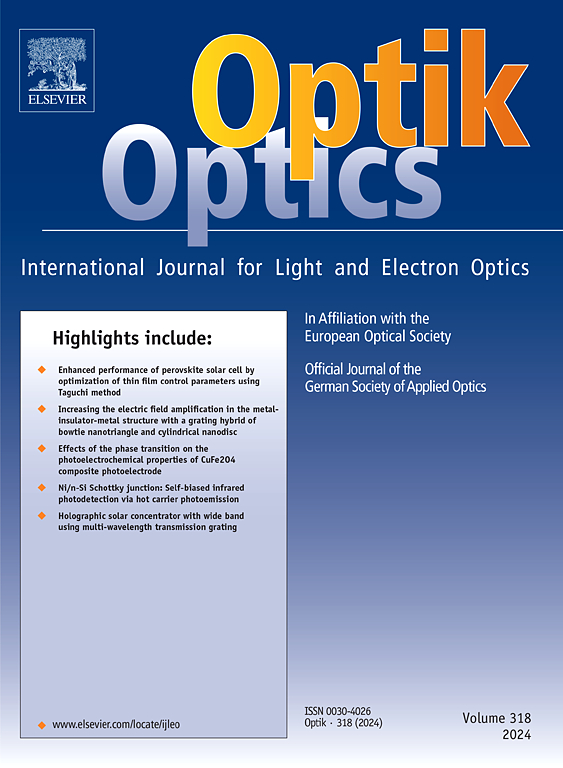Graphene-based frequency reconfigurable slot antenna for terahertz applications
IF 3.1
3区 物理与天体物理
Q2 Engineering
引用次数: 0
Abstract
This research presents the design of a multi-band frequency reconfigurable slot antenna (FRSA) that utilizes graphene in the terahertz (THz) regime. The proposed FRSA supports independent switching across twenty-nine operating bands: 0.518, 0.532, 0.56, 0.59, 0.636, 0.648, 0.66, 0.682, 0.724, 0.752, 0.758, 0.84, 0.938, 0.906, 1.166, 1.252, 1.256, 1.26, 1.304, 1.324, 1.336, 1.344, 1.532, 1.648, 1.70, 1.784, 1.95, 2.01, and 2.064 THz. The design features a rectangular patch with both vertical and longitudinal slots and incorporates seven graphene switches (labeled d1–d7) placed along these slots. These switches enable reconfigurability by controlling the surface conductivity of the graphene. The tunable properties of graphene present significant potential for developing smaller, reconfigurable antennas in THz wireless systems. The proposed FRSA features a compact design with dimensions of 268 µm x 240 µm x 10 µm, or 0.46 λ₀ × 0.41 λ₀ × 0.017 λ₀, where λ₀ represents the wavelength corresponding to the lowest operating frequency of 0.518 THz in free space. The patch structure is mounted on a 10 μm thick substrate made of Rogers RO3003 (with εr = 3 and tanδ = 0.001). The surface conductivity of graphene sheets is adjustable by applying a bias voltage, which influences the chemical potential of the graphene. The FRSA operates in ten states (S1–S10), determined by the ON and OFF positions of the graphene sheets. An analysis of the antenna performance was conducted, examining the reflection coefficient, and gain at various chemical potentials. This switching capability enables secondary users to access unused frequency bands, making the antenna suitable for cognitive radio applications. Furthermore, this technology can be applied in medical settings, as the antenna can assist in identifying skin conditions and cancerous tissues. By switching between different frequencies, it can improve imaging quality and capture various types of data about the body being examined.
用于太赫兹应用的基于石墨烯的频率可重构槽天线
本研究介绍了利用太赫兹(THz)石墨烯设计的多波段频率可重构插槽天线(FRSA)。所提出的 FRSA 支持 29 个工作频段的独立切换:0.518, 0.532, 0.56, 0.59, 0.636, 0.648, 0.66, 0.682, 0.724, 0.752, 0.758, 0.84, 0.938, 0.906, 1.166, 1.252、1.256、1.26、1.304、1.324、1.336、1.344、1.532、1.648、1.70、1.784、1.95、2.01 和 2.064 太赫兹。该设计采用了带有垂直和纵向槽的矩形贴片,并沿这些槽安装了七个石墨烯开关(标记为 d1-d7)。这些开关通过控制石墨烯的表面电导率实现了可重构性。石墨烯的可调特性为开发太赫兹无线系统中更小、可重新配置的天线提供了巨大潜力。拟议的 FRSA 设计紧凑,尺寸为 268 µm x 240 µm x 10 µm,即 0.46 λ₀ × 0.41 λ₀ × 0.017 λ₀,其中 λ₀ 代表与自由空间中 0.518 THz 最低工作频率相对应的波长。贴片结构安装在罗杰斯 RO3003(εr = 3,tanδ = 0.001)制成的 10 μm 厚基板上。石墨烯片的表面电导率可通过施加偏置电压进行调节,偏置电压会影响石墨烯的化学势。FRSA 在十种状态(S1-S10)下工作,由石墨烯片的导通和关断位置决定。我们对天线性能进行了分析,研究了各种化学势下的反射系数和增益。这种切换能力使次级用户能够访问未使用的频段,从而使该天线适用于认知无线电应用。此外,这项技术还可以应用于医疗环境,因为天线可以帮助识别皮肤状况和癌变组织。通过在不同频率之间切换,它可以提高成像质量,并捕捉有关被检查身体的各类数据。
本文章由计算机程序翻译,如有差异,请以英文原文为准。
求助全文
约1分钟内获得全文
求助全文
来源期刊

Optik
物理-光学
CiteScore
6.90
自引率
12.90%
发文量
1471
审稿时长
46 days
期刊介绍:
Optik publishes articles on all subjects related to light and electron optics and offers a survey on the state of research and technical development within the following fields:
Optics:
-Optics design, geometrical and beam optics, wave optics-
Optical and micro-optical components, diffractive optics, devices and systems-
Photoelectric and optoelectronic devices-
Optical properties of materials, nonlinear optics, wave propagation and transmission in homogeneous and inhomogeneous materials-
Information optics, image formation and processing, holographic techniques, microscopes and spectrometer techniques, and image analysis-
Optical testing and measuring techniques-
Optical communication and computing-
Physiological optics-
As well as other related topics.
 求助内容:
求助内容: 应助结果提醒方式:
应助结果提醒方式:


